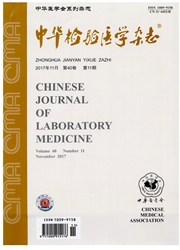

 中文摘要:
中文摘要:
目的 确定甲状腺过氧化物酶抗体(TPOAb)和甲状腺球蛋白抗体(TgAb)的阳性临界值,并探讨这两种抗体出现的临床意义。方法 1999至2000年对3个中国农村社区3761名进行甲状腺疾病流行病学调查,采血、尿标本,同时行甲状腺B超检查,2004年对该人群进行随访。所有血清标本均用固相化学发光酶免疫分析法测定TPOAb和TgAb及促甲状腺激素(TSH)水平。结果 甲状腺功能及形态正常人群(2437名)TPOAb和TgAb的95%正常可信区间上限分别为37.8IU/ml和38.6IU/ml。总人群(3761名)中随TPOAb浓度的升高发生TSH升高(〉4.8IU/m1)或降低(〈0.3IU/m1)的比率也呈阶梯式增加,但仅当TPOAb≥50IU/ml时,发生TSH异常率比TPOAb438IU/ml者的差异有统计学意义(P〈0.01)。同样TgAb≥40IU/ml时,发生TSH异常率比TgAb≤39IU/ml者差异也有统计学意义(P〈0.01)。当TPOAb以50IU/ml和TgAb以40IU/ml为阳性临界值时,总人群中TPOAb和TgAb的阳性率女性(11.71%、11.21%)显著高于男性(4.07%、2.68%)。抗体阳性人群的TSH水平显著高于抗体阴性组(P〈0.05)。原TSH正常抗体阳性人群(515名)随访发现甲状腺功能减退症的发生率显著高于抗体阴性人群(P〈0.05)。结论 用高灵敏性化学发光酶免疫分析法在尿碘中位数为100~600μg/L的普通人群中确定TPOAb和强Ab的阳性临界值分别为50IU/ml和40IU/ml。甲状腺自身抗体TPOAb和TgAb阳性是发生甲状腺功能损伤的重要危险因素。
 英文摘要:
英文摘要:
Objective To determine the cut-off points of thyroid peroxidase antibody (TPOAb) and thyroglobulin antibody (TgAb) and their clinical significance. Methods An epidemiological survey for thyroid disorders was carried out in 1999 to 2000 in three rural counties with MUI of 100-600μg/L in north of China. The above population was followed up in 2004. The serum and urinary samples were obtained from 3 761 subjects. Physical examination and thyroid B ultrasound were performed in those subjects. Serum concentrations of TPOAb, TgAb and TSH were measured by using of a highly sensitive chemiluminescence enzyme immune assay. Results ( 1 ) 2 437 subjects with normal TSH (0. 3 to 4. 8 IU/ml), normal thyroid ultrasound, and without history of thyroid diseases were selected. The upper limit of 95% confidence interval for TPOAb and TgAb in the selected subjects was 37.8 IU/ml and 38.6 IU/ml respectively. (2) The occurrence of abnormal TSH ( 〉 4. 8 IU/ml or 〈 0. 3 IU/ml) increased with elevated TPOAb level. The significant difference of the percentage of abnormal TSH was observed when compared TPOAb 〈 38 IU/L with TPOAb≥50 IU/L ( P 〈 0. 01 ) as well as compared TgAb≥ 40 IU/ml with TgAb 〈 39 IU/ml. (3) The positive rates of TPOAb and TgAb were 11.71%, 11.21% in women and 4. 07%, 2. 68% in men respectively when TPOAb 〉 50 IU/ml and TgAb 〉 40 IU/ml were used as cut-off points. (4) TSH level was higher in subjects with positive thyroid autoantibodies than those without antibodies (P 〈 0. 05 ). (5) In the follow-up survey, we found that the 5-year cumulative incidence of elevated TSH was higher in euthyroid subjects with thyroid autoantibodies than that without antibodies (P 〈 0.05). Conclusions The cut-off point of TPOAb and TgAb are 50 IU/ml and 40 IU/ml in general population with MUI 100 ~600 μg/L using a highly sensitive chemiluminescence assay. TPOAb and TgAb, which were often coexistence, are important risk factors in thyroid dysfunction.
 同期刊论文项目
同期刊论文项目
 同项目期刊论文
同项目期刊论文
 期刊信息
期刊信息
